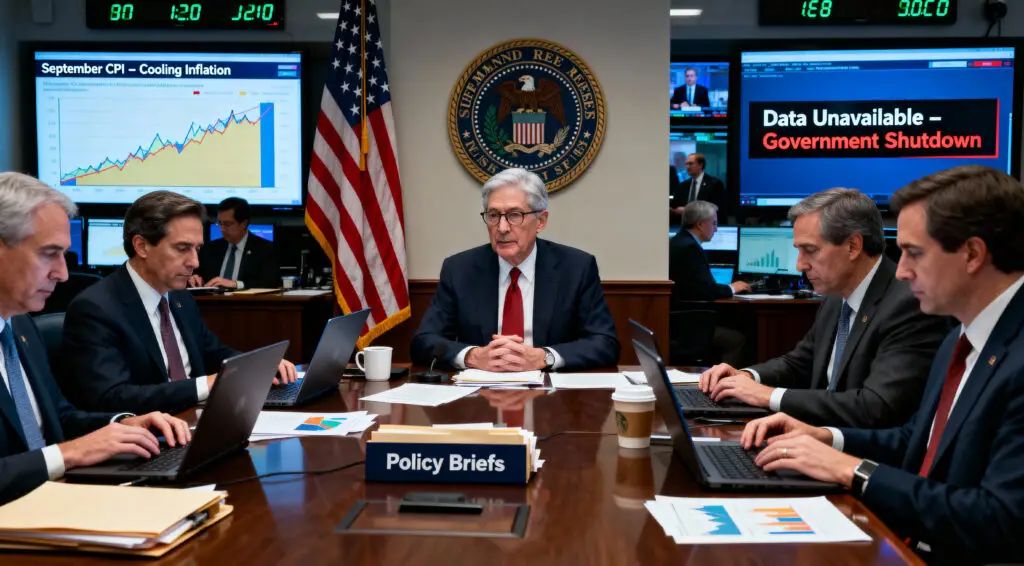Softer Inflation Report Gives Fed Temporary Breathing Room
The latest US inflation data brought a welcome surprise for policymakers, showing a modest decline in core price pressures during September. Cooling shelter costs, easing service inflation, and stable goods prices have given the Federal Reserve short-term confidence that inflationary risks are under control.
For investors, the report represented exactly what markets hoped for — a softer reading that supports the case for another rate cut. However, optimism may be short-lived. The ongoing government shutdown has frozen much of the nation’s economic reporting system, leaving the Fed without access to the critical data it depends on to shape policy decisions in the months ahead.
Fed Economists Warn of Data Gaps and Estimation Risks
Economists are sounding alarms that the Fed may soon be forced to operate without reliable economic insight. RSM chief economist Joe Brusuelas cautioned that “this is likely to be the last solid quality report we get until probably early next spring.” The Bureau of Labor Statistics, responsible for key data like employment and inflation, cannot collect new information during the shutdown — meaning future reports will rely heavily on estimation models.
Brusuelas explained that such imputations reduce accuracy and reliability, forcing policymakers to depend on guesswork rather than evidence. As a result, rate-setting decisions could hinge on outdated trends, further complicating efforts to balance inflation control with economic support.
Wall Street Warns the Fed Against Policy Shifts Without Data
Major banks have echoed similar concerns. Bank of America titled its latest Federal Open Market Committee (FOMC) preview “Don’t change course when flying blind,” advising the Fed to remain cautious while the data blackout continues. The bank expects the central bank to deliver a 25-basis-point rate cut in its upcoming meeting but avoid offering clear forward guidance due to limited visibility into the economy.
Without access to updated labor or consumer spending data, the Fed risks oversteering — either easing too quickly amid inflation risks or tightening too soon against a fragile recovery. The uncertainty underscores the difficulty of monetary policymaking in a data-deprived environment.
Recommended Article: US Federal Reserve Expected to Cut Rates Again Despite Data Gaps From Government Shutdown
Emerging Tariff Pressures Threaten Inflation Stability
Despite the benign inflation reading, signs are emerging that tariffs are beginning to push prices higher across several categories. Apparel, footwear, and household furnishings all saw early signs of price firming in September, suggesting that tariff costs are slowly filtering into consumer prices.
BlackRock’s chief investment strategist Gargi Chaudhuri warned that “goods prices are firming again amid tariff pressures.” Economists fear this trend could accelerate if companies continue facing rising import costs while depleting inventories and shrinking profit margins.
Analysts Expect Tariff Pass-Through to Consumers in 2026
Financial institutions such as BNP Paribas and Goldman Sachs predict more noticeable tariff-related inflation by early 2026, especially in trade-sensitive sectors. Bank of America economist Steven Juneau added that tariffs will remain a “source of goods price inflation” for several quarters as businesses pass higher costs on to consumers.
While many companies have so far absorbed these costs to protect sales, analysts expect this buffer to erode as global trade tensions persist. The resulting inflationary pressures could force the Fed to reconsider its rate-cut path once data collection resumes, especially if prices reaccelerate in early 2026.
Fed Faces Growing Uncertainty Heading Into Year-End
For now, the Fed finds itself navigating through a fog of incomplete information. Chair Jerome Powell and his team must make critical policy decisions based on limited data, balancing short-term relief from lower inflation against long-term risks from tariffs and economic stagnation.
With economic data frozen, inflation expectations fragile, and policy decisions increasingly reliant on estimates, the Fed’s path forward has rarely been more uncertain. As Brusuelas put it, “The Fed is flying blind” — and the coming months will test just how steady its hands remain on the controls of the US economy.























